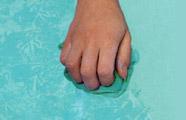| Plain, well painted walls
with well chosen colours definitely have a style of their own. But there are a
number of interesting patterned effects you can try on your walls to give it an
entirely different look.
The patterned effects are created with one or more colours
of paint on top of another using rags, sponges, brushes etc or printing designs
(Stenciling) equidistantly with a contrast colour, on
the wall. The overall effect is determined entirely by the choice of colours.
Combining several shades of the same colour or closely related pastels gives a
soft, gentle effect, whereas choosing contrasting bold colours will create a more
dramatic finish. Be different.. try one of these innovative effects in your
room and give it a character of its own.
Method 2 Method 1:
Pressing a crumpled rag dipped in paint, gives a crinkled look
all over the wall. This method is more effective when a darker shade of the
same colour is ragged on to a lighter base coat.
Base coat : Apply a base coat with a
light shade of your choice. Use a 4 to 6 inches wide brush. Start with
horizontal strokes from the top of the wall in a specific area and cover with
vertical strokes before the paint dries in the same area to give a good finish. Repea t
and cover up the whole wall. Allow the base coat to dry. t
and cover up the whole wall. Allow the base coat to dry.
Dilute the colour
to be ragged on i.e a darker shade of the base colour and spoon some into a
bowl. Crumple up a piece of rag. Dab it into the paint until it is fairly drenched
then press on to a piece of lining paper to test the impression. If you are
not satisfied with the pattern, crumple the rag more to get the desired effect.
Then press the rag
gently on the wall. Raise your hand from the wall, turn it slightly and press
the rag onto an adjoining area. The spaces between pressings should be kept
fairly even. When the impressions start fading, refill the rag with paint, keeping it bunched as it is to continue the same
print or crumpling again for a more random effect.
Top
Method 2 :
For creating this effect, a satin
enamel paint is used and it requires two people working at the same time; one
for painting and the other for rolling off the paint immediately before the
paint dries up. This method gives a more marked wrinkled effect.
Base coat : Apply a base coat
of thin latex paint with a
light shade of your choice. Use a 4 to 6 inches wide brush. Start with
horizontal strokes from the top of the wall in a specific area and cover with
vertical strokes before the paint dries to give a good finish. Repeat the
process until the whole wall is painted. Allow the base coat to dry.
 A number of rags cut to about 1ft
square and size should be kept ready before starting the work. A top
coat of a satin enamel paint diluted with white spirit, is
applied over the base coat in
strips 2ft wide by one person, and simultaneously rolled off with a bunched up rag by the
second person. A number of rags cut to about 1ft
square and size should be kept ready before starting the work. A top
coat of a satin enamel paint diluted with white spirit, is
applied over the base coat in
strips 2ft wide by one person, and simultaneously rolled off with a bunched up rag by the
second person.
The top coat should be applied with
vertical strokes from the top to the bottom of the wall and the paint is rag
rolled off the wall working from the bottom to the top. Roll a piece of rag as
shown in figure about 6in wide. Hold between two hands, then roll up the painted
strip, lifting off (removing) the top coat paint in between, to
reveal the base coat. When the rag becomes paint-soaked, re-roll it to produce a
clean surface or use a new rag.
After finishing rolling off one whole
strip on the wall, overlap the first strip slightly with the rolled rag
for the next strip. When painting the next strip, leave an edge of about 2in next to the second strip of paint being applied so
that the rag rolling can run right up the joint, making the two painted areas
merge completely.
Top |


